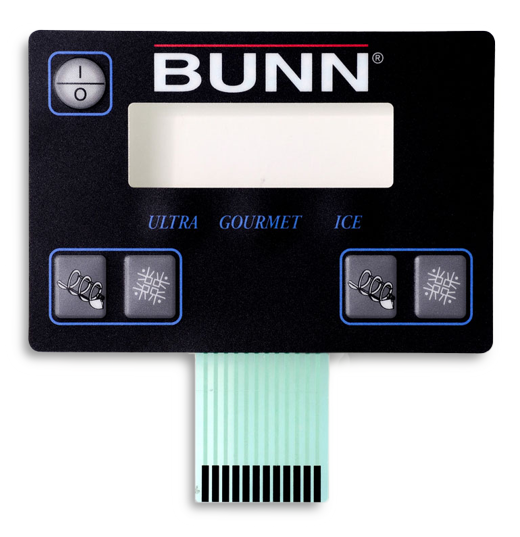Membrane Switch: Reliable, Cost-Effective, and User-Friendly Control Systems
Comprehending Membrane Changes: The Trick to Sturdy and Trustworthy Controls

What Are Membrane Buttons?
Membrane layer switches are an advanced solution in the world of interface innovation, integrating performance and style effortlessly. These gadgets function as a user interface between customers and electronic systems, incorporating several elements right into a small layout. Typically constructed from flexible, thin layers of materials, membrane buttons are designed to respond to touch, enabling individuals to connect with equipment and digital tools effectively.
The key aspects of a membrane layer button consist of a published circuit layer, graphic overlay, and a spacer layer that avoids unintentional activation. The visuals overlay can be tailored to mirror brand name identification or individual preferences, boosting aesthetics while making sure functionality. Membrane switches are commonly made use of in numerous applications, consisting of clinical devices, consumer electronic devices, and industrial equipment, owing to their toughness and resistance to environmental factors such as dampness and dirt.
One of the crucial advantages of membrane buttons is their capability to endure wear and tear, making them ideal for high-traffic environments. Additionally, they are light-weight and need minimal room, enabling for innovative styles in product growth. Generally, membrane changes represent a efficient and functional choice for modern-day electronic user interfaces, marrying modern technology with user-centric style concepts.
Exactly How Membrane Layer Switches Work
The operation of membrane layer switches over joints on a basic yet reliable device that converts individual input right into digital signals. When a user presses the switch, the leading layer deforms, enabling a conductive component in the circuit layer to make call with a corresponding conductive pad on the underside of the graphic overlay.
The design of membrane layer buttons can vary, but they usually incorporate domes or tactile aspects to offer comments to the individual, enhancing the overall experience - membrane switch. The materials made use of in membrane switches, such as polyester or polycarbonate, contribute to their longevity and resistance to ecological factors, including wetness and dust. The published circuits are generally enveloped, which shields them from wear and tear over time.
Advantages of Membrane Buttons

Furthermore, membrane layer switches are understood for their sturdiness. Constructed from robust materials, they are immune to dirt, moisture, and physical wear, which considerably prolongs their life expectancy compared to standard mechanical buttons. This sturdiness makes them particularly ideal for high-traffic settings and applications needing long life.
One more substantial benefit is the ease of cleaning and click here to find out more upkeep. The smooth surface area of membrane layer changes lessens dirt build-up and is usually invulnerable to spills, making them ideal for settings that need constant sanitization.
Furthermore, membrane layer buttons use a streamlined account, leading to a thinner style that can be integrated into different gadgets without including mass. This function not only boosts the visual appeal however likewise contributes to a much more ergonomic item style.
Applications of Membrane Buttons
User-friendly and flexible, membrane buttons locate applications throughout a large range of industries, including clinical tools, customer electronics, and commercial tools. In the medical area, these buttons are important to gadgets such as analysis equipment, person monitoring systems, and infusion pumps, where dependability and convenience of cleansing are crucial. Their capacity to keep and stand up to rough settings functionality makes them excellent for such applications.

In customer electronics, membrane buttons are used in products like microwaves, washing devices, and push-button controls - membrane switch. Their sleek design permits user-friendly interface, boosting the total customer experience while offering resilience and resistance to tear and put on
Commercial equipment also benefits from membrane layer buttons, specifically in control panels for machinery and automation systems. These switches supply defense versus dirt and wetness, guaranteeing regular efficiency in challenging settings. Moreover, their personalized features permit manufacturers to tailor them to details operational demands, improving efficiency and capability.
Selecting the Right Membrane Layer Switch Over
When selecting a membrane button, it is important to think about different elements that affect efficiency and viability for details applications. The primary factors to consider consist of ecological problems, tactile responses, sturdiness, and style specs.
First, examine the operating environment; buttons subjected to dampness, chemicals, or severe temperature levels call for specific products to make sure longevity and functionality. Next, examine the need for responsive feedback. Depending on individual interaction, some applications might gain from a tactile action to verify activation, while others might favor a non-tactile style for aesthetic reasons.
Durability is another critical factor; membrane layer buttons ought to be developed to hold visit this website up against constant use, impacts, and abrasion. Guarantee the picked switch can withstand the anticipated lifecycle, especially in high-usage scenarios.

Verdict
In final thought, membrane switches over offer as essential components in the design of review trusted and sturdy control systems across numerous sectors. Their compact style, incorporated with durable construction and adjustable functions, enhances individual interaction while making sure long life popular settings. The adaptability of membrane layer switches permits tailored solutions that satisfy certain functional demands, strengthening their value in modern-day technology. As sectors remain to progress, the value of incorporating reliable membrane button solutions can not be overemphasized.
Membrane changes represent an important facet of contemporary interface layout, blending performance with resilience in numerous applications.Membrane buttons are an innovative solution in the world of user interface innovation, combining performance and design flawlessly. Usually created from adaptable, slim layers of materials, membrane layer switches are designed to respond to touch, enabling users to engage with machinery and digital gadgets efficiently.
The style of membrane switches can differ, but they frequently incorporate domes or responsive components to offer responses to the customer, improving the overall experience.In verdict, membrane switches offer as necessary components in the style of reputable and long lasting control systems throughout different markets.